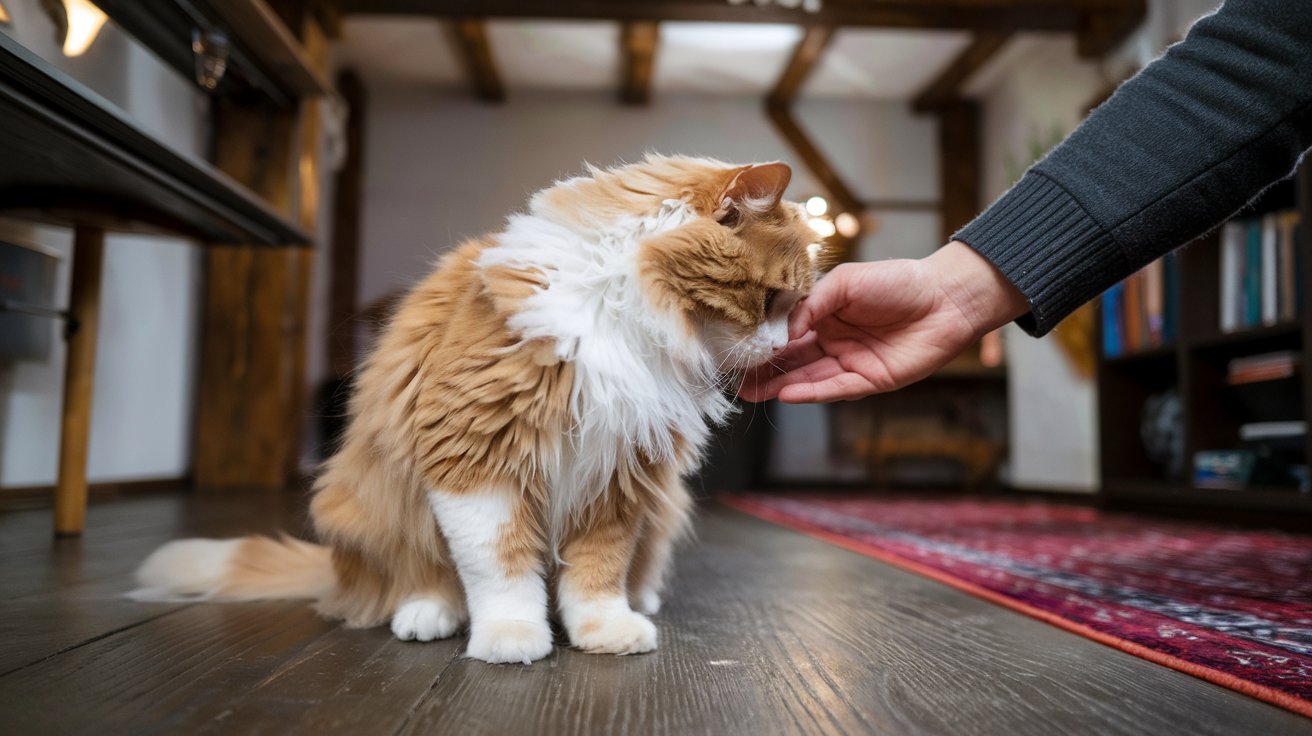Introduction
Cats are amazing animals that are known for being both independent and loving. Despite their often aloof demeanor, they have unique ways of communicating with humans and other animals. Understanding cat behavior is essential for forming a deeper connection with them. Through a mix of vocal sounds, body language, and physical gestures, cats express their emotions, needs, and social bonds in ways that, while subtle, are deeply meaningful.
Cats communicate using both verbal and non-verbal cues. Their meows, purrs, and hisses convey a range of emotions—from affection to frustration—while non-verbal signals like tail movements, ear positions, and facial expressions provide further insights into how they feel. They communicate with humans and other animals by physical gestures including head butting, touching, and kneading. One particularly interesting form of communication is head butting, also known as bunting.
Head butting is a common behavior in cats where they gently nudge their head against you. This isn’t just a random action; it’s a strong gesture of trust and affection. Through bunting, cats mark you with their scent, using glands located on their head, which serves as a way to claim you as part of their territory and to express that they feel safe around you. This act of bonding, though small, is a powerful symbol of the relationship they share with those they trust.
What is Cat Head Butting?
Cat head butting, also known as bunting, is a form of communication where a cat gently presses or nudges its head against a person, another animal, or even an object. The main emotions expressed by this behavior are affection and trust. Cats have scent glands located on their heads, particularly around the cheeks and forehead, and when they engage in head butting, they’re transferring their scent to mark their territory. In feline language, this is a way to establish a social connection and signal that they view the recipient as part of their safe space.
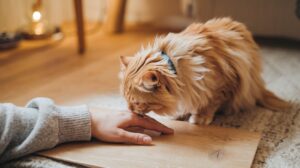
Head butting is typically a voluntary and affectionate action, showing that the cat feels comfortable and secure in its environment. It’s a bonding ritual often shared between cats and their trusted humans, but they may also bunt other animals or familiar objects in their surroundings. Unlike aggressive or defensive behaviors, head butting is a sign of positive intent, making it one of the clearest indicators that a cat sees you as part of its social circle.
Differences Between Head Butting and Other Feline Behaviors Like Rubbing
While head butting and rubbing might seem similar, there are distinct differences between the two. Both behaviors involve a cat using its head or body to make contact, but the intent and execution vary. Rubbing, for instance, often involves a cat sliding its entire body along a surface or person, usually focusing on the sides of the face or the body. This can be a more passive way of marking territory and spreading scent, but it also communicates comfort and familiarity.
Head butting, however, is more direct and intimate. It specifically involves the head and tends to be more forceful than a typical rub, carrying a more personal touch. While rubbing may be part of a routine habit for cats, head butting is a conscious action to show trust, often reserved for those with whom they share a close bond. Essentially, rubbing is a general sign of marking territory, whereas head butting is a deliberate gesture of affection and social connection.
Why Do Cats Head Butt?
Marking Territory
Cats use head butting as a way to mark their territory, utilizing the scent glands located on their forehead, cheeks, and chin. These glands release pheromones that are unique to each cat, and when they bunt a person, object, or other animal, they are essentially “claiming” it as part of their domain. By transferring their scent, they signal ownership and ensure their environment smells familiar and safe. This scent-marking behavior is a natural instinct, helping cats create a space that feels secure, and filled with their own comforting smell.
Affection and Bonding
Beyond marking territory, head butting is one of the most personal ways a cat shows affection and bonds with its human companions. When a cat bumps its head against you, it’s not just marking you as part of its territory—it’s expressing trust and emotional connection. Cats reserve head butting for those they feel truly safe with, making it a powerful indicator of a strong bond. It’s their way of saying, “I trust you,” and building a deeper relationship with their humans. This intimate gesture often leads to other affectionate behaviors, such as purring and nuzzling.
Socializing
Cats also use head butting as a social tool, especially when interacting with other animals. Among cats, bunting helps establish and maintain social bonds. When one cat head butts another, it’s often a friendly gesture that strengthens their connection. In multi-cat households, this behavior plays a role in maintaining harmony, as it helps cats communicate a sense of unity and trust. Head butting among animals, just like with humans, is a positive sign of familiarity and social engagement, helping to reinforce the sense of community within their social group.
Comfort and Familiarity
Head butting also contributes to a cat’s sense of comfort and security. By spreading their scent, cats create a familiar environment where they feel at ease. This behavior helps reduce stress by ensuring that their surroundings are marked with their own scent, which provides a calming effect. Whether they’re interacting with humans, other pets, or objects, head butting allows them to build an environment that feels consistent and safe. The act of bunting, in itself, is a sign that the cat feels comfortable and relaxed in its environment, knowing that it’s surrounded by familiar scents and bonds.
Head Butting vs. Head Pressing
While head butting is a normal and affectionate behavior in cats, head pressing is something entirely different and can indicate a serious health issue. Understanding the distinction between these two behaviors is crucial for cat owners to ensure their pet’s well-being.
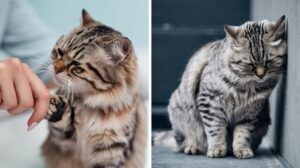
Normal Head Butting
Head butting is a friendly, intentional gesture that a cat performs to show affection, trust, and comfort. It involves the cat gently nudging their head against you, another animal, or a familiar object. This behavior, which usually comes with relaxed body language or purring, denotes a happy and healthy cat. Head butting is usually a positive, social interaction that helps cats bond with those around them.
Dangerous Head Pressing Behavior
Head pressing, on the other hand, is an alarming behavior in which a cat compulsively presses their head against walls, floors, or other hard surfaces. Unlike head butting, this behavior is not affectionate and could be a sign of an underlying medical condition. Cats engaging in head pressing often do so persistently and may appear disoriented or distressed. This behavior is usually a response to pain, discomfort, or neurological issues and requires immediate veterinary attention.
Signs of Potential Medical Issues
If a cat is pressing its head against walls or hard surfaces, it could be a symptom of serious conditions such as brain tumors, liver disease, poisoning, or head trauma. Other signs that often accompany head pressing include circling, excessive vocalization, disorientation, vision problems, and seizures. These behaviors should not be ignored, as they could point to severe neurological or systemic problems that need to be addressed by a veterinarian as soon as possible. Early intervention is crucial to diagnosing and treating the underlying cause.
What Should You Do When Your Cat Head Butts You?
How to Handle Head Butting by Your Cat
When your cat head butts you, it’s a clear sign that they trust and feel affection toward you, so responding in kind can help reinforce that bond. A gentle stroke on their head or back is a good way to reciprocate the affection. Cats often enjoy being petted in the areas where they use their scent glands, such as behind the ears or along the cheeks, so giving attention to these spots can enhance their sense of comfort. Some cats may even start to purr or nuzzle further as a response to your affection. A soft voice or gentle acknowledgment of their action can also deepen the connection.
It’s important to allow your cat to initiate and lead these interactions, as they value personal space. Respecting their boundaries while showing them affection when they ask for it creates a positive environment for your pet. In some cases, head butting may also be a way for your cat to get your attention, so paying attention to their other cues—like if they’re hungry, want to play, or need companionship—can further strengthen the bond.
Encouraging Positive Behavior and Building a Stronger Bond
Head butting is a natural, positive behavior that reflects a deep connection between you and your cat. Encouraging this behavior helps build trust and reinforces the idea that they can come to you for affection and comfort. Consistently responding in a loving and gentle way when your cat head butts you letting them know that you appreciate and reciprocate their affection. You can further encourage bonding by spending quality time with your cat through gentle play, talking to them softly, or simply sitting near them while they relax.
Respecting your cat’s need for autonomy, while offering love and attention when they seek it, creates a harmonious relationship. Cats are independent creatures, but they also cherish routine and familiarity, so fostering an environment where they feel safe, loved, and understood is key to maintaining a happy and healthy bond.
Do All Cats Head Butt?
Variations in Personality
Not all cats engage in head butting, as a cat’s personality plays a big role in their behavior. Just like humans, cats have individual temperaments, and while some may be naturally affectionate and social, others might be more reserved or independent. Head butting is often seen in cats that are more confident and comfortable with physical contact. Cats who are shy or anxious may be less likely to exhibit this behavior, preferring to express affection in subtler ways, such as sitting close by or following their owners around. Even though head butting is a common way for cats to bond, it’s important to remember that every cat shows love differently.
Some cats may prefer to rub their body or cheeks against you, knead with their paws, or simply enjoy quiet companionship. It doesn’t mean they don’t trust or love you; it’s just a reflection of their unique personality and comfort level with physical interaction. So, while head butting is a sweet gesture of affection, its absence doesn’t necessarily indicate a lack of bond between you and your cat.
Breeds That Are More Likely to Head Butt
Certain cat breeds are known for being more social and affectionate, making them more prone to head butting. Breeds like the Siamese, Ragdoll, Sphynx, and Maine Coon tend to be highly interactive with their owners and enjoy physical closeness. These breeds are known for their loving nature and are more likely to engage in behaviors like head butting, purring, and rubbing to express affection.
On the other hand, some breeds, such as the British Shorthair or Russian Blue, may be a bit more independent and less likely to exhibit head butting as a regular behavior. While they can still be affectionate, they may show it in more reserved ways. Each cat is different, and even within breeds, individual personality will determine whether a cat prefers head butting as part of their social interaction.
Other Common Cat Affection Displays
Purring
Purring is one of the most well-known ways that cats express their devotion. While purring can sometimes indicate discomfort or stress, it is most often a sign of contentment and happiness. When your cat curls up beside you, gently purring, it’s a clear indication that they feel safe and comfortable in your presence. Cats will often purr when they are being petted or when they are in a familiar, peaceful environment. This sound is not only soothing for them but also serves as a way to communicate their positive feelings toward their humans.
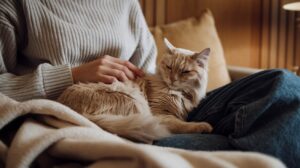
Kneading
Kneading, or the “making biscuits” behavior, is when cats press their paws rhythmically against soft surfaces like blankets, pillows, or even their owners. This behavior originates from kittenhood when cats knead their mother’s belly to stimulate milk flow. As adults, kneading is often a comforting action that cats associate with safety and security. A cat showing you a lot of love and trust, and an indication that you are a safe and soothing person in their lives, is when they knead on you.
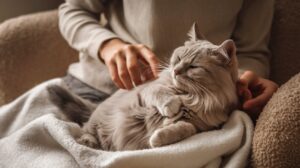
Slow Blinking
A “cat kiss,” or slow blinking, is a mildly aggressive way to show affection. Cats will often gaze at their owners with soft eyes and blink slowly as a way of saying, “I trust you.” In the wild, closing their eyes around another animal would make them vulnerable, so when your cat slow blinks at you, it’s a significant sign that they feel relaxed and safe. You can even mimic this gesture to communicate back, as slow blinking is a way of returning their affection.
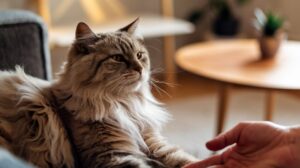
Head Rubbing
In addition to head butting, cats also show affection by rubbing their cheeks or body against you. This behavior is a way for them to leave their scent on you and mark you as part of their “territory,” but it’s also a sign of closeness. Cats often rub against their humans’ legs or hands, signaling that they enjoy your company and want to share their scent with you as part of their social bond.

Recognizing Different Forms of Affection
Understanding the difference between various displays of affection requires paying attention to your cat’s body language and the context of the behavior. Purring and kneading are typically associated with feelings of comfort and happiness, while slow blinking and head rubbing often signal trust and a desire for connection. Cats may not always seek physical closeness, but when they engage in these behaviors, they are offering you their affection in their own unique way. Learning to recognize and respond to these gestures helps strengthen your bond and creates a more fulfilling relationship with your feline companion.
Conclusion
Head butting is a meaningful and endearing behavior in cats, reflecting their affection, trust, and desire for social connection. By gently nudging their head against you or other familiar objects, cats mark their territory with their scent, signaling that they see you as part of their safe and secure environment. This simple yet powerful gesture not only indicates a strong bond but also helps establish and reinforce their social relationships, whether with humans or other animals.
Understanding and respecting your cat’s communication style is crucial for building a healthy and fulfilling relationship. While head butting is a clear sign of love and trust, it’s important to recognize that each cat has its unique ways of showing affection. By paying attention to their behaviors—whether it’s purring, kneading, or slow blinking—you can better respond to their needs and deepen your bond. Embracing your cat’s individual communication style helps ensure they feel valued and understood, fostering a stronger, more loving connection between you and your feline friend. Cat staring at the owner is different from head butting.
FAQs
What does it mean when a cat head butts me?
A cat head butt is an expression of trust and loyalty. Cats have scent glands on their heads, and by head butting, they are marking you as part of their territory and showing that they feel comfortable and safe with you.
Is head butting the same as head pressing?
No, head butting and head pressing are different behaviors. Head butting is a friendly gesture of affection, where the cat gently nudges you with its head. Head pressing, however, involves a cat persistently pressing its head against hard surfaces and may indicate a medical issue requiring veterinary attention.
Do all cats head butt?
Not all cats engage in head butting. Each cat has its own personality and ways of showing affection. While some cats may frequently head butt as a sign of love and trust, others may express their affection through different behaviors like rubbing, purring, or sitting close by.
Which cat breeds are more likely to head butt?
Breeds known for their social and affectionate nature, such as Siamese, Ragdoll, Sphynx, and Maine Coon, are more likely to head butt. These breeds tend to be more interactive with their humans and enjoy close physical contact.
What should I do if my cat is head pressing?
If your cat is head pressing, it could be a sign of a serious health issue, such as neurological problems or pain. It’s important to seek veterinary advice promptly if you notice this behavior, especially if it’s accompanied by other symptoms like disorientation or seizures.
What’s the best way to get my cat to express love?
Encourage your cat to show affection by responding positively to their affectionate behaviors, such as head butting, purring, and kneading. Spend quality time with your cat, offer gentle petting, and respect their comfort level to strengthen your bond.
How do I differentiate between different forms of cat affection?
Different forms of cat affection can be identified by their context and accompanying body language. Purring and kneading typically indicate comfort and contentment, while slow blinking and head rubbing are signs of trust and closeness. Paying attention to these cues will help you better understand your cat’s emotional state and how they express their love.
